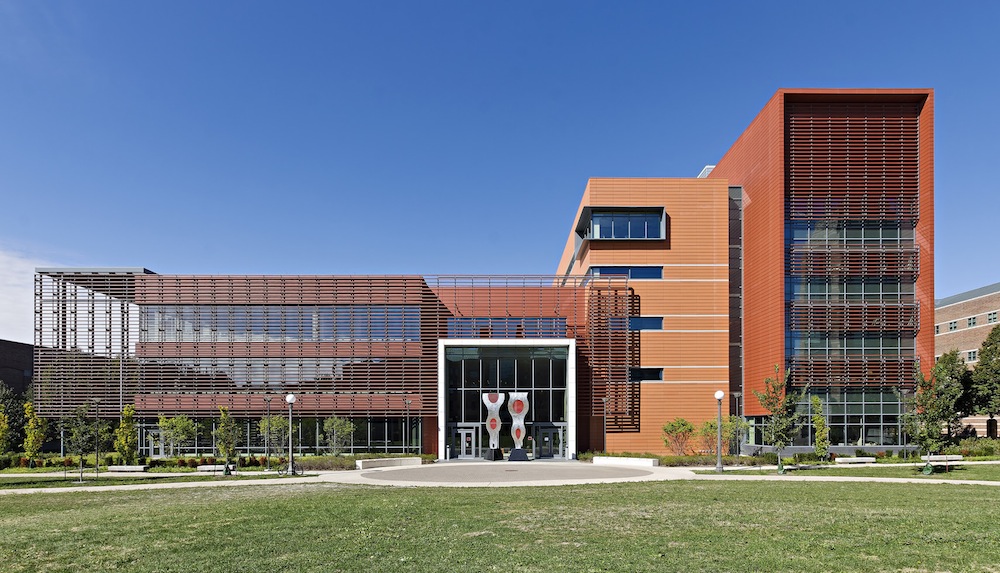The University of Illinois’s new Electrical and Computer Engineering Building has been named R&D Magazine’s 2016 Laboratory of the Year.
SmithGroupJJR designed the $95 million, 230,000-sf research facility. Located on the school’s Urbana campus, the ECE Building contains the Department of Electrical and Computer Engineering (ECE Illinois), which is known for its research in transistors, integrated circuits, LEDs and plasma displays.
The award, in its 50th year, honors new and renovated labs that promote sustainable practices and creativity in the design of modern laboratories.
The designers stressed energy efficiency. The building uses 50% less energy than minimum building energy efficiency standards, and it is targeting a LEED Platinum certification. Some of the sustainable feature include high-performance LED lighting, heat recovery chillers with net metering, and a chilled beam cooling system.
A terra cotta rainscreen system covers 70% of the building envelope, while double paned glass covers the remaining 30. Solar screens and a three-story canopy of angled louvers protect the building’s glazing from solar heat gain.
At nearly double the size of the old Everitt Laboratory, the ECE Building has space for separate labs and classrooms, and a lobby with communal seating.
"Our goal was to deliver a building that represents the stature of this world-renowned department, positions its students and researchers at the forefront of emerging technology, and acts as a catalyst for efficient building energy standards on the ILLINOIS campus,” SmithGroupJJR Project Manager Carolina Lopez, AIA, LEED AP BD+C, said in a statement. “This award is a testament of that unparalleled effort and proof that this facility goes beyond bricks and mortar to represent the department’s mission and values.”
Two Illinois-based firms were also on the Building Team. Williams Brothers Construction was the prime contractor and KJWW Engineering Consultants served as mechanical engineer. Construction was completed in 2014.
Related Stories
| Nov 3, 2010
First of three green labs opens at Iowa State University
Designed by ZGF Architects, in association with OPN Architects, the Biorenewable Research Laboratory on the Ames campus of Iowa State University is the first of three projects completed as part of the school’s Biorenewables Complex. The 71,800-sf LEED Gold project is one of three wings that will make up the 210,000-sf complex.
| Nov 3, 2010
Seattle University’s expanded library trying for LEED Gold
Pfeiffer Partners Architects, in collaboration with Mithun Architects, programmed, planned, and designed the $55 million renovation and expansion of Lemieux Library and McGoldrick Learning Commons at Seattle University. The LEED-Gold-designed facility’s green features include daylighting, sustainable and recycled materials, and a rain garden.
| Nov 3, 2010
Recreation center targets student health, earns LEED Platinum
Not only is the student recreation center at the University of Arizona, Tucson, the hub of student life but its new 54,000-sf addition is also super-green, having recently attained LEED Platinum certification.
| Nov 3, 2010
Virginia biofuel research center moving along
The Sustainable Energy Technology Center has broken ground in October on the Danville, Va., campus of the Institute for Advanced Learning and Research. The 25,000-sf facility will be used to develop enhanced bio-based fuels, and will house research laboratories, support labs, graduate student research space, and faculty offices. Rainwater harvesting, a vegetated roof, low-VOC and recycled materials, photovoltaic panels, high-efficiency plumbing fixtures and water-saving systems, and LED light fixtures will be deployed. Dewberry served as lead architect, with Lord Aeck & Sargent serving as laboratory designer and sustainability consultant. Perigon Engineering consulted on high-bay process labs. New Atlantic Contracting is building the facility.
| Nov 3, 2010
Dining center cooks up LEED Platinum rating
Students at Bowling Green State University in Ohio will be eating in a new LEED Platinum multiuse dining center next fall. The 30,000-sf McDonald Dining Center will have a 700-seat main dining room, a quick-service restaurant, retail space, and multiple areas for students to gather inside and out, including a fire pit and several patios—one of them on the rooftop.
| Nov 1, 2010
John Pearce: First thing I tell designers: Do your homework!
John Pearce, FAIA, University Architect at Duke University, Durham, N.C., tells BD+C’s Robert Cassidy about the school’s construction plans and sustainability efforts, how to land work at Duke, and why he’s proceeding with caution when it comes to BIM.
| Oct 13, 2010
Editorial
The AEC industry shares a widespread obsession with the new. New is fresh. New is youthful. New is cool. But “old” or “slightly used” can be financially profitable and professionally rewarding, too.
| Oct 13, 2010
Campus building gives students a taste of the business world
William R. Hough Hall is the new home of the Warrington College of Business Administration at the University of Florida in Gainesville. The $17.6 million, 70,000-sf building gives students access to the latest technology, including a lab that simulates the stock exchange.
| Oct 13, 2010
Science building supports enrollment increases
The new Kluge-Moses Science Building at Piedmont Virginia Community College, in Charlottesville, is part of a campus update designed and managed by the Lukmire Partnership. The 34,000-sf building is designed to be both a focal point of the college and a recruitment mechanism to get more students enrolling in healthcare programs.
| Oct 13, 2010
Residences bring students, faculty together in the Middle East
A new residence complex is in design for United Arab Emirates University in Al Ain, UAE, near Abu Dhabi. Plans for the 120-acre mixed-use development include 710 clustered townhomes and apartments for students and faculty and common areas for community activities.
















